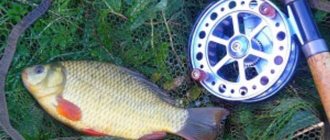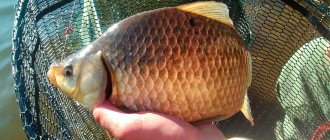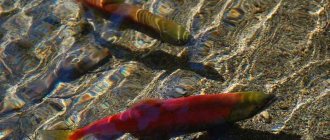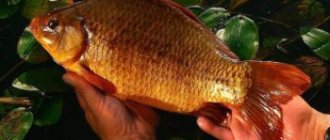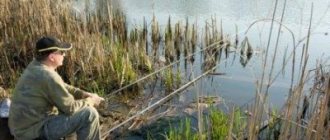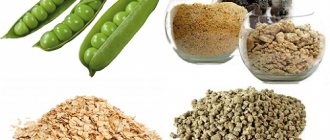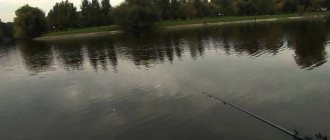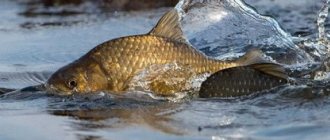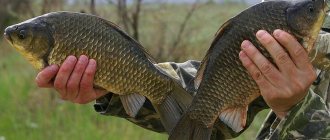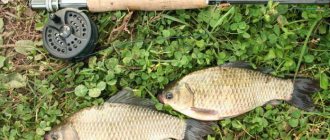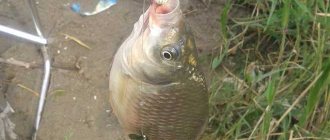Every angler has encountered a situation of complete lack of bite, when the crucian carp categorically refused to be interested in the bait. Often it got to the point where not a single bite was observed throughout the entire day. Such fishing leaves only a feeling of disappointment and a lot of questions as to what is the reason for such strange behavior of the fish and why does it not bite?
The absence of a crucian bite can be due to many factors that should be taken into account by every fisherman
Weather and bite
Of course, there are many factors that influence why crucian carp refuses to bite. But the most common reasons for the lack of bite are unfavorable weather conditions. The activity of fish and its appetite are negatively affected by the following:
- high air temperature (more than 27°C);
- changes in atmospheric pressure;
- sudden cold or warming;
- strong wind;
- hot sunny weather.
When the street is warm, cloudy and there is a slight wind, catching a couple of crucian carp will not be difficult even for a beginner. But in the heat and during sudden changes in weather, which happens quite often in June and July, the fish are not active. This is due to changes in the oxygen regime in the water and different pressure on the swim bladder. Crucian carp either go to greater depths or swim in the upper layers, completely ignoring the bait at the bottom.
Weather conditions have a great influence on the bite of crucian carp
Strong wind also negatively affects the bite - it creates a large wave and thereby scares the fish. If there is a slight drizzle or there are ripples on the water, then the chances of a good catch increase sharply. This is again explained by the oxygen content. Small waves and bubbles from raindrops falling into the water significantly increase the oxygen concentration, which contributes to the activity of crucian carp in searching for food.
Why doesn't the crucian carp bite?
Crucian carp, like most fish of the carp family, lacking a stomach, is forced to eat more often than other types of fish.
The fish adheres to the principle of little by little and more often, but even such a particularly unpretentious fish is characterized by interruptions in feeding.
The reasons for the lack of bite of crucian carp include:
- air temperature less than eight degrees or more than 270C (weather conditions, changes in atmospheric pressure);
- spawning period;
- inappropriate time of day;
- the fishing area is incorrectly selected (bottom topography, vegetation, current);
- plentiful food supply and lack of competition (the fish are simply always full);
- noisy environment on the shore of the reservoir;
- water condition (water bloom period);
- the bait is incorrectly selected;
- a sharp drop in water level in a reservoir;
- the composition and quantity of complementary foods is incorrectly selected;
- the bait supply depth is incorrectly selected;
- rough tackle.
Advice: before you go fishing, and the fishing place is not familiar to you, try to find out as much information as possible about the fishing area and the “predilections” of its inhabitants. If it was not possible to obtain information before the trip, it does not matter, it can be obtained from local fishermen or during fishing by observing the local “natives”.
Weather and bite
Not only humans, but also fish also do not like bad weather conditions. Therefore, it is necessary to pay attention and be observant when choosing the time to catch crucian carp, taking into account the weather conditions.
So, with a sharp increase in atmospheric pressure, crucian carp need to physically compensate for the difference in pressure and maintain balance in their swim bladder; for this, the fish has to float from the bottom to the upper layer of water; in such conditions, the fish is clearly not interested in your bait.
When atmospheric pressure decreases, crucian carp, on the contrary, trying to compensate for the difference in the swim bladder and outside, begins to move from the surface to the bottom, and the fish tends to choose the deepest parts of the reservoir.
When the atmospheric pressure decreases, crucian carp does not stop feeding and, being at the bottom, constantly moves in search of food.
With a sharp cold snap and a drop in water temperature, crucian carp may hibernate, or even bury themselves in the mud; here you should not count on successful fishing at all.
Favorable weather conditions include:
- low atmospheric pressure;
- light rain (during rainfall, the oxygen content in the water increases, which has a beneficial effect on the activity of fish);
- clean water (no blooms);
- moderate water and air temperature;
- a slight wind (creates a disturbance in the layers of water in which food for fish rises from the silt and its surface).
Time and bite
The best times of day for catching trophy crucian carp are the hours before sunrise and at sunset.
At night you can also count on fish bites, but in the daytime with low clouds, the water warms up, the percentage of oxygen in the water decreases, and at the same time the activity of the fish.
Bait and bite
The crucian carp is as capricious in its culinary preferences as a small child; just yesterday it was delighted with the bait offered, but today it refuses to even look in its direction.
Therefore, it is necessary to have in your arsenal as diverse a “menu” as possible for the capricious gourmet.
You can seduce crucian carp:
- baits of plant origin;
- animal origin.
Bait of animal origin includes:
- bloodworm;
- maggot;
- earthworm and dungworm;
- pupated fly larvae;
- beetles;
- insects living in a pond.
Baits of plant origin include:
- steamed corn kernels;
- pearl barley;
- rye flour dough;
- mash based on semolina.
Advice: in the spring, preference should be given to bait of animal origin, and with the onset of stable heat and warming up of the water, bait of plant origin. If there is no bait, a crumb of freshly baked bread mixed with vegetable oil and the addition of a small amount of garlic and boiled potatoes will help you out.
Spawning
At the end of May and June, crucian carp spawning begins in most reservoirs. At this time, the fish is completely occupied with procreation, not responding to any bait. The beginning and end of spawning are quite difficult to determine. On a small pond it can begin even in mid-May if the water temperature has time to warm up to 15°C. In medium and large lakes, the spawning period occurs at the beginning of summer.
Most often, spawning takes place in June and takes about 4-5 days. The fish needs the same amount of time to recover, “get over the disease” and start feeding again. Therefore, when going fishing in May and June, keep in mind that you can get caught in the spawn and be left without a catch, despite the wide selection of baits and good gear.
During the spawning of crucian carp it is better to postpone fishing
When to catch crucian carp
Crucian carp begins to behave actively when the water temperature rises to +10°C, and already at a temperature of +15°C it begins to actively peck.
Crucian carp feels great in conditions where the water temperature is between +18-23°C. It is these indicators that need to be taken into account when organizing fishing.
In spring and autumn, you should also focus on water temperature indicators. As a rule, during these periods he begins to be interested in bait at 10-11 o’clock and until 16-17 o’clock. In the summer, crucian carp begins to bite even before sunrise, and in the evening active biting begins only after 17:00.
But these terms are considered very conditional, since the biting mode of crucian carp is not the same, even if the reservoirs are located nearby. This is due both to the availability of food supply and to the size and depth of the pond.
In ponds where the food supply is poor, crucian carp may be interested in bait throughout the daylight hours.
Incorrectly selected gear
Typically, crucian carp weighing from 200 to 400 grams bite. Catching a large specimen over 1 kg is a real rarity. Therefore, when fishing for cautious crucian carp, gear should be light and inconspicuous. Otherwise, he may see a thick line or feel unnatural resistance when biting, because the angler uses a large number of sinkers or a heavy float when rigging.
Often, inexperienced fishermen do not know about this and try to fish with “rough” gear. For example, they use floats weighing from 3 grams, fishing line with a thickness of 0.2 mm or very large hooks that the fish cannot swallow.
Often the lack of bites can be explained by an incorrectly selected bait supply depth. Crucian carp try to feed from the bottom, and when the hook with the bait is higher, they completely ignore it.
Those who like to fish with a feeder often make the following mistakes - they make leashes that are too short and place heavy feeders, which create a lot of noise when casting and scare away the crucian carp. When fishing with bottom gear, it is also important to use the correct type of rig so that the fish can hook themselves. Otherwise, it will simply pull the bait, and the angler will not even see the bite.
Fishing success depends on the right gear
In the pond
In artificial ponds, crucian carp always appears first. This is due to the fact that it is quite tenacious and can exist in conditions where any other fish simply cannot survive. Therefore, in any hole with water, sooner or later, crucian carp will definitely appear.
In newly formed ponds, where the food supply has not yet been formed, crucian carp moves around the water area in a school, comes close enough to the shore and bites on any bait that is offered to it.
In such reservoirs, crucian carp can be successfully caught using any gear, regardless of the leashes and the thickness of the main line. The only thing that can hinder the crucian bite is the weather, which always makes its own adjustments to the fishing process.
Finding crucian carp in a pond
In already established ponds, after some time, other species of fish appear, both peaceful and predatory. In such conditions, crucian carp have to decide on their permanent and temporary stopping places. Therefore, in such ponds you will have to look for crucian carp or attract it to the fishing site with the help of bait.
Baiting is when the future fishing spot is baited for several days in a row. If the food is added regularly, the crucian carp will come to this place on the day of fishing. Unfortunately, this method cannot always be used. It is more suitable for local fishermen who can feed the place at any time.
If this method cannot be implemented, then you can resort to electronic means of determining the location of the fish. In such cases, it is preferable to use an echo sounder.
Lure
In any case, crucian carp requires a lot of bait, otherwise fishing may not take place. All bait that is planned to attract crucian carp must be divided into three parts. One of these parts needs to be rolled into balls the size of an orange and thrown into the water. Basically, they make a spot bait spot, although there are cases when good results are obtained with a spaced feeding method, when the bait is distributed over a large part of the water area.
The second part of the prepared bait will have to be thrown out in about an hour if there are no bites. In case of bites, the place needs to be fed before each cast.
Mistakes in feeding and choosing bait
Another reason for poor bite or no bite at all can be improperly used complementary foods while fishing. For example, if you use bait with a high protein content (cake, chopped worms, maggots, etc.) in hot weather in June, then it is in vain to count on its effectiveness. At this time, the fish is “sick” after spawning and prefers sweetish smells and plant foods.
In addition, in the heat, complementary foods can quickly deteriorate. An inattentive fisherman who uses it himself contributes to a decrease in the bite. Sour bait will not only not attract fish, but, on the contrary, will scare it away from the fishing spot. Therefore, in summer it is recommended to use purchased bait mixtures, which are made in portions directly on the shore.
The lack of bites is often explained by the wrong choice of baits. Of course, as children, we all dug worms, took a fishing rod and went to catch crucian carp with them. Naturally, most often such fishing did not bring a catch, but this is understandable. After all, it is a mistake to limit yourself to one bait option.
In order not to be left without a catch, you should have with you several options for bait and groundbait for crucian carp
Crucian carp are distinguished by their inconsistency of taste - today they bite only on maggots, and tomorrow only on dough with honey. You will never be able to guess which bait will be effective here and now. Therefore, the lack of a bite is often the result of fishing with a non-working bait. How to avoid this? It's quite simple. Take more than 5 bait options with you when fishing. There should be both animal bait (maggots, worms, bloodworms, etc.) and plant bait (dough, corn, bread, etc.).
Collection of fishing gear
crucian carp killer
This tackle got its formidable name due to the fact that its design is made in such a way that the crucian carp has practically no chance of freeing itself after swallowing the bait.
The essence of the gear is very simple. A sinker and successively several spring feeders are attached to the end of the fishing line, each of which has a leash with a hook attached. Various versions of this design are sold in stores, but it is not very difficult to make it yourself.
The principle of operation of this fishing device is reminiscent of feeder fishing, only there are usually 3 feeders, and they are located on the main line, and not on a separate leash.
The design allows you to catch not only crucian carp; often carp and even bream are caught on it.
The disadvantages of the gear include the difficulty of casting, the noise that such a cast makes, and the low visibility of the bite. In addition, it should be used for long casts, since fishing near the shore will be ruined by small fish.
Float rod
The most common type of gear used to catch fish of this species. True, supporters of the bottom design, such as the crucian killer, argue that it is the bottom options that allow you to catch large specimens, but this is a very controversial issue.
Fishing for crucian carp with a float rod gives the fisherman true pleasure. There is nothing to compare the characteristic bite of this fish, when the float first trembles slightly, and then lies down and moves to the side. Here the catch needs to be hooked in time. And not only because he can get off the hook, it doesn't happen that often. Fishing for crucian carp is usually carried out in places with dense vegetation; the fish caught there can take away the tackle, then snagging or tangling of the fishing line is almost inevitable.
They catch crucian carp using a regular Bolognese telescopic fishing rod. But swing options are also possible.
Floats are usually used thin, sliding, with great sensitivity. Sinkers, like hooks, are also recommended to be used in small sizes.
Donka
Bottom tackle for crucian carp differs little from the bottom tackle, which is used for other types of fish. It is a sinker on the main line. from which leashes with hooks extend. The classic version does not allow other additions; they will be discussed later.
Catching gear for large, deep reservoirs with a flat bottom.
Significant disadvantages of donkey include the need for clean water in the place where it is cast and reeled in, otherwise breaks and entanglements will ruin the whole fishing.
Many fishermen pre-clear the bottom fishing area of vegetation, but this should be done in advance. Crucian carp is a shy and cautious fish. Manipulations in the water can alarm him so much that he will leave this place for a long time.
Feeder
Feeder gear was invented for carp fishing, but it is also quite suitable for crucian carp. The principle of fishing with a feeder is simple, but quite effective. Using a special feeder rod, both a leash with a hook and a feeder with bait are thrown into the water at the same time. Initially, you can throw one feeder with starter food to attract fish. The feeder, by the way, also serves as a sinker, which lowers the entire structure to the bottom.
A bite is indicated by a special tip at the end of the rod, which is called the tip. The tips are removable, they can be changed depending on the fishing conditions and the size of the expected trophies.
The disadvantages of feeder gear include a certain difficulty in casting, the mandatory presence of a special fishing rod and frequent tangling of the gear if the design is not made entirely correctly.
Pacifier
Now this original tackle can be purchased in stores, but many fishermen make it themselves, it’s not difficult.
It is enough to take an ordinary cap from a plastic bottle, preferably with a wide neck, attach a lead plate to it as a weight, and tie several leashes with hooks to the edges of the cork.
Now the inside of the cork is filled with bait, and hooks with bait are embedded in the bait.
The crucian carp is attracted by the aroma of the bait and the turbidity rising from it; it approaches the plug thrown into the water with the help of a rod, begins to suck in the bait and inevitably swallows the hooks. Then it cuts itself.
Some fishermen even use small foam balls as bait, the main thing is that the crucian carp does not feel the hook at first.
Other fish can also be actively caught on a nipple or plug, it all depends on the composition of the bait.
Makushatnik
Catching crucian carp on the top is an ancient fishing method that was actively used by our grandfathers and great-grandfathers. Now he is not very popular, and in vain. This kind of fishing does not require much physical or material expenditure.
Makukha is a briquette of waste that appears from the production of sunflower oil. This is also called cake . Such cake can be easily purchased today in every fishing store. It is usually sold in the form of large circles or briquettes. From this amount you should cut (do not break, as everything will crumble) into small briquettes measuring approximately 4 by 5 cm.
Now they can be attached to a steel plate of similar size using, for example, rubber bands. The main fishing line and hooks with leashes are attached to the plate by rings.
Then, as in a nipple, the hooks are recessed into the top of the head. The tackle is ready.
To cast it, they usually use a feeder rod (it is stronger than usual) or even cast the tackle like a donkey. Once in the water, the cake will immediately begin to spread an odor that is attractive to crucian carp throughout the water area. The crucian carp will discover it and begin to suck in fragments of the top along with the hooks.
The only drawback of the makushatnik is that on a muddy bottom it can drown in silt, and the fish simply will not notice it, and the cake will not be washed away.
Spring
We have already talked about crucian carp killer gear, when several feeder springs are used at once. You can use one. It is more convenient and faster to manufacture.
Hooked leashes are usually attached to the feeder itself or to the main line that runs through it. The last option is called sliding; the stopper on the line can be set at a certain distance. Then the crucian carp, swallowing the bait with a hook, will not immediately feel any resistance and will hook itself after a while when trying to swim away.
Rubber
Catching crucian carp with a rubber shock absorber is quite popular today. However, not everyone is satisfied with the somewhat cumbersome design and the relative complexity of the initial casting.
Making gear is not difficult. An elastic band is tied very tightly to the sinker (which must be heavy). And at the other end there is a fishing line with leashes and hooks. It is enough to throw such a structure once in the right place, so that you can then pull it ashore only with a fishing line and leashes during a bite.
You remove the fish from the hook, release the line, and the elastic band tightens again and sends the bait back to its original place.
Installation features:
- all structural elements must be tied to each other very securely;
- the elastic band should stretch at least 3 times;
- It is better to choose a round cross-section; a rectangular one quickly wears out and breaks;
- For a sinker, you can use a railroad spike or half a brick.
Place and time of fishing
An incorrectly chosen fishing location can also cause a bad bite. For example, in summer it is almost impossible to successfully catch crucian carp in shallow water. However, many anglers continue to cast bait into areas with a depth of about 30-40 cm, where the high water temperature becomes uncomfortable for fish. A similar situation is observed in the spring. An inexperienced fisherman tries to catch crucian carp in deep-sea places and holes. But he forgets that at this time there is practically no food here, and all the fish stay close to the shore.
If the water level on a pond or lake drops sharply, which is quite often observed in the summer, then this will certainly lead to a decrease in the bite, because crucian carp need time to adapt to new conditions. Often it does not bite even when the bottom of the reservoir is covered with dense vegetation. The crucian carp simply does not see the bait in a thick layer of algae. The fish do not bite even during the period of blooming water, which most often takes place in the middle of summer.
The success of fishing directly depends on the characteristics of the reservoir chosen for catching crucian carp
If the reservoir has a rich food supply and there are no other species of fish, then crucian carp often neglects the bait. However, the presence of predatory fish also negatively affects the bite. There are reservoirs where, hiding from pike or perch, it bites least in the morning and during the day, preferring to look for food at night.
In general, it is extremely important to take into account the time of fishing. After all, there are certain hours during which the fish practically do not bite. In summer it is daytime. From approximately 10 am to 6 pm. The sunny and hot weather takes its toll. If we talk about early spring, then, on the contrary, the bite in the morning hours is always weak. The water does not have time to warm up, and the crucian carp practically do not move around the reservoir.
There are several other good reasons for poor bite. Firstly, there is noise on the shore, which scares the fish. If there is a group of young people nearby swimming in the water and having fun, then it is better to look for a quieter place. Secondly, when you are fishing in open areas with shallow depths, remember to wear camouflage and be as inconspicuous as possible. The fish is very careful and attentive to the coastal zone, therefore, when it notices something wrong, it stops biting.
Depending on the time chosen for catching crucian carp, the success of fishing also depends
Secrets of catching crucian carp
Crucian carp is not only capricious, but also a very cautious fish, therefore, to achieve a positive result when catching it, you need to pay attention to:
- bait;
- groundbait;
- weather conditions,
- installation of fine gear.
When installing gear for fishing for crucian carp, you should use a fishing line that is close in color to the color of the water, or blue.
Depending on the place of fishing, when using bottom tackle, it is necessary to use a fishing line that matches the color of the bottom.
Trophy specimens of crucian carp should be looked for in areas of reservoirs with sharp changes in bottom topography and the presence of deep holes.
For fishermen who have a swimming device, it is advisable to pour about 1/2 a bucket of sand onto the bottom before feeding a promising place.
This trick will create a white spot on the dark bottom and attract the attention of the fish to the fishing spot. After you have attracted the attention of the fish and fed the place, you need to keep the crucian carp in the fishing area.
This can be achieved by preparing a mixture of the following ingredients:
- cereals;
- makha (cake);
- liquid (from a can of canned corn);
- garlic (as an attractant);
- biscuits;
- cocoa powder;
- a little dill.
Advice: when adding attractants to bait, you should remember that in excess quantities, strong-smelling components can bring a negative result. Do not add attractant to the entire volume of bait, but prepare a small experimental amount.
What to do if there is no bite
Of course, you can simply pack up all the gear and go home, but there are several ways to “make” the fish interested in the bait. To do this, you need to follow the following tips:
- Change the fishing location, because it may be that where you cast your fishing rods there is a lot of silt or algae that prevents the fish from seeing the bait.
- Do you have the necessary fishing gear? Then remake the tackle using thinner fishing line, smaller hooks and lighter floats.
- Change the depth. It’s rare, but it happens that crucian carp feed not from the bottom, but in the middle layers of water. This is due to changes in atmospheric pressure, which affects the swim bladder of the fish and prevents it from staying at the bottom.
- Experiment with baits. Try different combinations, such as a maggot and corn sandwich. You can add another flavor to the dough or change its consistency (make it thinner or thicker).
Thanks to the video you will learn how to properly catch large crucian carp:
What do crucian carp bite on?
Some consider crucian carp to be an omnivorous fish. This is partly true, but still the catchability of a particular bait depends on the fishing conditions, time of year and characteristics of the reservoir.
Plant attachments
Crucian carp switches quite safely to plant baits in the summer. There is a lot of such protein food in the reservoir at this time of year, it is easy to get, and you don’t have to migrate for a long time. Experienced fishermen say that this fish can even peck on pieces of reeds in the summer.
The main vegetable baits when fishing for crucian carp are:
- semolina chatter; crucian carp really loves this bait; It is noteworthy that you can prepare it from a small amount right on the shore, using local water;
- boiled pearl barley; This is also a very tasty dish for the type described; after cooking, it is better to leave it in a thermos, adding a little sugar and salt; some fishermen advise adding a little honey to it;
- steamed wheat; You can also use millet cereals; when boiled, they make a very easy-to-make dough;
- steamed peas; Some enthusiasts generally claim that this particular bait for crucian carp is the most effective. Only legumes should be used whole, not crushed;
- boiled corn , you can also use canned corn;
- dough with flavors and additives;
- just bread , preferably a loaf.
Animal origin
In the spring, crucian carp bite well on maggots, bloodworms, or a combination of these elements. You can use cockchafer or dragonfly larvae, this is just in season.
In summer, preference is given to worms, maggots and larvae. They bite on bloodworms only in June. Then he stops paying attention to him altogether. The fact is that under natural conditions bloodworms are almost never found after June. And in nutritional value it is inferior even to plant food.
Closer to autumn, crucian carp are attracted by worms, underleaves, and crawlings. He willingly pecks at large larvae - protein animal food is just in place for cold weather.
Crucian carp can peck at the red worm until the freeze-up.
Artificial bait
They are usually used in the spring during the period of rapid activity of crucian carp. At other times of the year, artificial baits are supposed to be used for predatory fish species.
The most effective artificial bait is colored foam balls. If you also provide them with flavoring, a good catch is quite possible.
Some spinners manage to catch crucian carp using silicone larvae. Only the wiring technique should be slow, with numerous stops. Crucian carp is a slow and calm fish. He will not chase a fast larva; he likes almost motionless prey.
Fishing technique and tactics
Describing the types and assembly of gear, we have already talked a little about this. Now let's summarize the main points.
- On the killer of crucian carp.
The technique of such fishing is simple, but requires certain rules:- It is advisable to use bait in advance;
the consistency of the bait should resemble plasticine;
- Styrofoam can be used as bait on hooks;
- the worm can be used not entirely, but in small pieces;
- the rod should be equipped with a sensitive bite alarm, maybe even a sound or light one.
- For a float rod:
- fish should be fed before fishing;
when fishing on a pond with a large number of fishermen, bait can be used only once to initially attract fish;
- the thinner the line, the greater the likelihood of a bite;
- It is better to use pellets for sinkers; voluminous heavy tackle will force cautious crucian carp to spit out the bait;
- You can use several leashes, but at different heights to avoid tangling.
- On the donk:
- the tackle can be used in reservoirs without or with weak currents;
- it is the donka that allows you to catch large specimens in the pond, which almost do not rise to the surface of the water;
- allows you to fish in large ponds and lakes far from the shore;
- It is not advisable to use it in areas with dense vegetation.
- To the feeder:
- the proximity of the feeder and bait makes such fishing effective even when the bite is inactive;
- Initially, only feeders with a large supply of feed are cast;
- to check the gear, you should regularly check it and re-throw it;
- Additional bait is given in small doses.
- On the pacifier:
- the viscosity of the bait should be higher than usual;
some hooks can not be buried in the mixture, but placed nearby;
- hooks should be small;
- It is better to place small pieces of animal baits in the plant elements of the bait.
- Makushatnik:
- pay special attention to the freshness of the cake; its rancidity or possible smell of rotting will discourage fish;
- For crucian carp, the pieces of macaque should not be made large;
- It is better to cast from a boat.
- Spring:
- when using sliding tackle, react to the jerk, and not just to the trembling of the fishing line;
- when fishing in the current, the bait should not be washed out quickly;
- using more than 2 hooks in this gear is impractical.
- Rubber:
- It is better to lower the sinker into the water from a boat;
- just pulling on the line indicates the approach of the crucian carp, you need to wait for the jerk;
- when gripping the bait, the elastic usually softens the resistance of the fishing line, and it also softens the jerks of the fish when fishing.
Animal baits
Worm
So, among the first and most popular baits with which crucian carp are caught can be called a dung worm. He doesn't need any special introduction. I can only say that crucian carp are caught using it almost all year round, but there are exceptions. I would like to draw your attention to the fact that you must always select a dung worm, which always has a red color that is attractive to fish and holds well on the hook.
Maggot
The next excellent bait that crucian carp bites well is maggot. Essentially, maggots are the larva of a blowfly. It is often used instead of the worm or in combination with it. It even happens that maggots are repainted in red or yellow shades, using special dyes for this. Under certain conditions, this improves the bite.
Bloodworm
Bloodworms are considered another good protein bait for crucian carp. And although bloodworms are not a typical bait for this fish, crucian carp go for it quite consistently, especially in cold weather. Personally, I often used bloodworms not only as bait, but also as one of the components of bait for crucian carp. This usually happened in winter (from ice) or late autumn.
